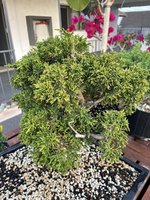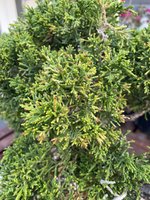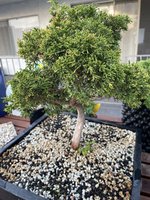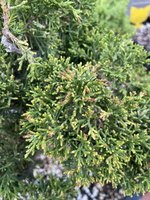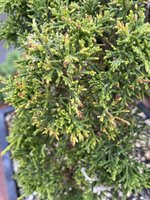@Bonsai Nut
Im seeing Tip Blight Phomopsis at this time, is this normal? or those only show on spring?
These can also be signs of poor root systems and/or working a tree out of season. Since you're just shown up on the forum, I think it's easy to mistake dying foliar tips with tip blight. That's an assumption from my end. They look almost identical to an untrained eye.
I strongly believe that if I'd made a new account and upload some pictures of the juniper I nearly killed this year, everyone would tell me it's tip blight. But it's not. It's dead roots not feeding the foliage, and the foliage not being strong enough to overcome that damage within a season. Tip blight would be more persistent.
Pictures always help. Take a mental note that tip blight (a fungal infection) sporulates, for this they need fruiting bodies (mushrooms, in essence). These fruiting bodies look like black specks, almost like regular bathroom molds but concentrated on the outside of a scale or needle. It's a fun exercise if you can find them in a google search for juniper tip blight. If these specks aren't present within a week after browning, it's
not tip blight. Even needle junipers have those specks if it's tip blight. Heck, I'll even dare to put some money on it that half of the "tip blight" isn't even tip blight, but root or sap flow issues instead. Yes, junipers get their strength from their foliage.. But something needs to feed that foliage and when it doesn't, the system needs a reboot. This happens by killing off the most demanding parts of the foliage - with the same visual cues as tip blight, but minus the specks - and rebuilding from older or more solidified foliage. We tend to mist when we damaged roots, and then "tip blight" happens.. A wrong connection of the wrong dots.
I have junipers laying around in the undergrowth, constant humidity, very little sun and very little wind.. None of them, from Chinensis to Media, to Itoigawa, wildtype scropulorum and even ERC and osteospermum, none of them get tip blight. Not even the ones prone to tip blight.
Unless there's some heavily infected plant in the vicinity (like half a mile), tip blight is a pretty rare occurrence. It can and will happen from time to time, absolutely! But I really think that most of us are diagnosing the issue backwards.
Antibiotics seem to help some people because they don't just kill tip blight, they kill everything that's eating those damaged roots in poor conditions - most antifungal antibiotics also attack a broad range of yeasts and bacteria because those use the same biochemical pathways as fungi. Antibiotics can be beneficial and solve acute issues, but they're a temporary fix.

